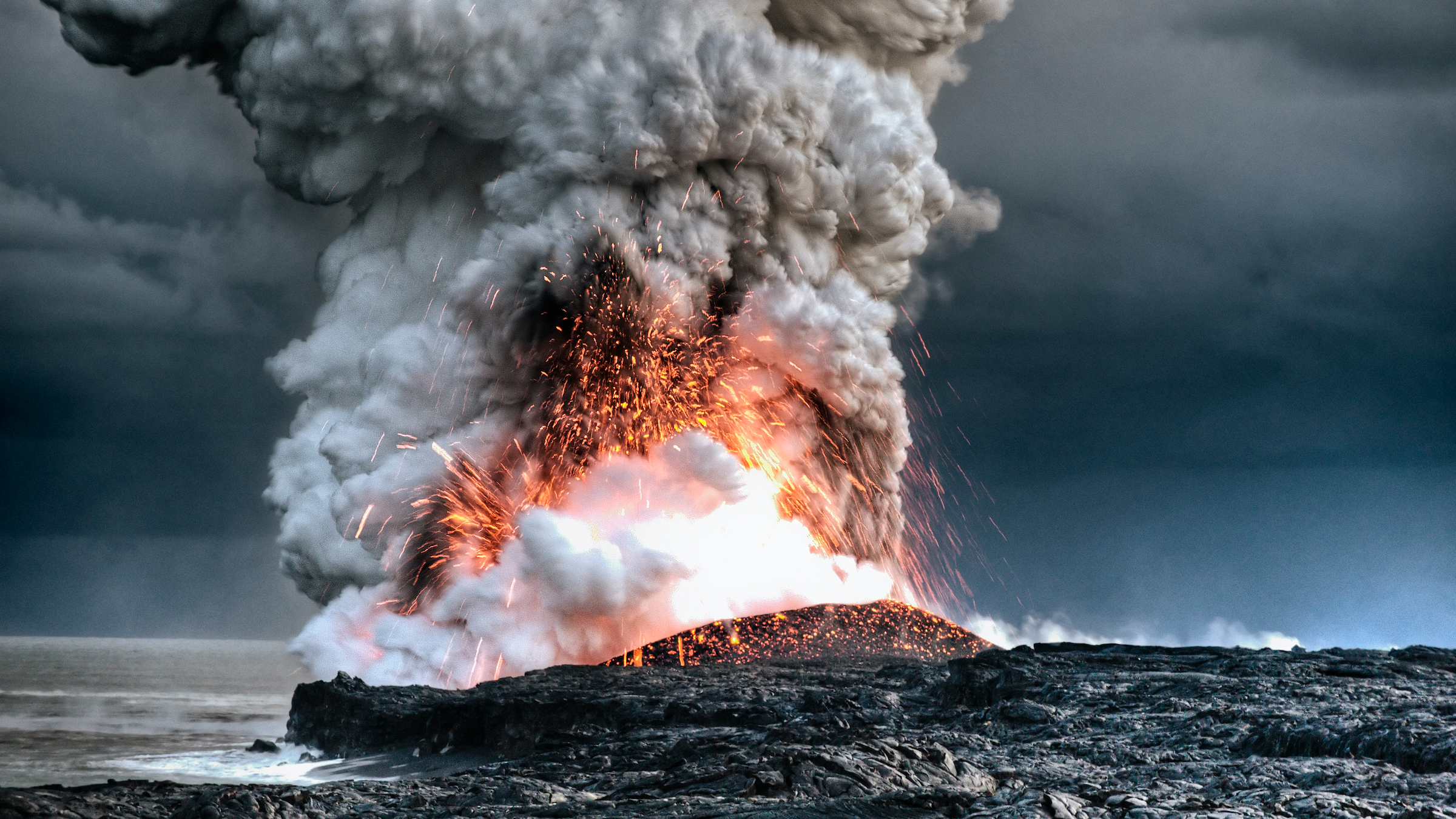
Where are most of Earth's volcanoes?
Is it the ring of fire? Or somewhere else?

There are around 1,350 "potentially active volcanoes worldwide," according to the U.S. Department of the Interior, and just over one-third of them are known to have erupted at some point during recorded history.
But where are most volcanoes located? If you wanted to see an active volcano, where would you have the greatest chance of finding one?
"Most of the planet's volcanoes are located underwater, along the 65,000-km-long [40,000 miles] mid-ocean ridge system," Ed Llewellin, a professor of volcanology at Durham University in the United Kingdom, told Live Science in an email.
"About 80% of the Earth's magma output comes from volcanoes along these ridges, which are typically 3 to 4 km [1.8 to 2.5 miles] below the ocean surface," he added. "Some of the ridge system — around 9,000 km [5,600 miles] — runs through the eastern Pacific, but it also runs through all of the major oceans, including 16,000 km [9,900 miles] along the middle of the Atlantic."
Related: Why does wood catch fire, but metal doesn't?
"It can be easy to forget about these volcanoes," Llewellin said, because they are hidden far beneath the ocean's surface, and as a result, their eruptions rarely affect us. But what about volcanoes that are above the ocean's surface?
"Of the volcanoes that are on land, many of them are located around the Pacific Ocean," Llewellin said. "This is because the Pacific Ocean is fringed with 'subduction zones,' which are places around the edges of tectonic plates where one plate slides underneath another."
Sign up for the Live Science daily newsletter now
Get the world’s most fascinating discoveries delivered straight to your inbox.
As a result of this tectonic activity, the Pacific is home to the Ring of Fire, a 25,000-mile-long (40,000 km), horseshoe-shaped, seismically active belt that is the epicenter of around 90% of the world's earthquakes and 75% of the world's active land volcanoes.
Around the Pacific, old, cold, dense oceanic plates "slide underneath the adjacent continental plates," Llewellin noted. As these plates descend back into the mantle, they release water from minerals formed at the ocean floor, and this water causes the mantle above to melt, producing magma.
"The magma rises up from the mantle above the descending plate and finds its way through the overlying continental plate," Llewellin explained. "This is why there are ranges of volcanoes all around the Pacific, such as the Andes in South America, the Cascades in North America, the Aleutians between Alaska and Siberia, and so on."
In the western Pacific, the subduction zones "mainly feature one oceanic plate sliding underneath another oceanic plate," Llewellin said. This can form chains of volcanic islands, such as the Japanese archipelago, and much of Melanesia, a subregion of Oceania in the South Pacific that contains Fiji, Vanuatu, the Solomon Islands and Papua New Guinea.
However, because of the nature of tectonic movements, the Pacific has not always been a volcano hotspot. Indeed, 252 million years ago, as the Permian period turned into the Triassic, Earth would have been far less hospitable due to the scale of volcanic activity occurring planetwide. At this time, what is thought to be the largest ever mass extinction event took place, with an estimated 96% of marine life and 70% of terrestrial life going extinct largely because of powerful volcanic eruptions, according to a 2017 article in the journal Nature.
Fortunately for humans and Earth’s other current inhabitants, volcanic eruptions aren't as numerous these days as they were in the planet's past.
"If we include submarine volcanoes along the mid-ocean ridges, the bulk of volcanic activity on Earth has been located outside the Pacific area," Llewellin said. "Over the whole history of the Earth, the frequency of volcanic activity has slowly fallen. The early Earth was much hotter than it is today — so hot that we think there were periods when the whole surface of the Earth was covered in a magma ocean."
Evidence of this red hot ocean is "preserved in the chemistry of ancient rocks from Greenland," which indicates that, 3.6 billion years ago, "a deep sea of incandescent magma" stretched across Earth's surface, according to a 2021 study published in the journal Science Advances.
"The last time this happened was following the giant impact of a Mars-sized proto-planet, which led to the formation of the moon around 100 million years after the Earth formed," Llewellin said, describing the theory known as the Big Splash, or the Theia Impact. "During these magma ocean periods, you could argue that the whole planet was a giant volcano!"
Earth is far cooler and more hospitable now than it was during its seas of magma phase, and according to Llewellin, volcanoes will eventually become a thing of the past on our planet given the planet seems likely to continue cooling over time.
"This has already happened on the moon," Llewellin said. "It is much smaller than the Earth, and so it cooled more quickly. There was intense volcanic activity on the moon billions of years ago — the large dark patches we see are giant 'seas' of solidified lava — but it has been volcanically 'dead' for around a billion years."
However, it seems unlikely that volcanoes will disappear any time soon. In fact, some experts have suggested it could take 91 billion years for the Earth's core to lose all its heat, meaning volcanoes are likely to be around for far longer than humans, and could even outlast the sun, which will likely die in 5 billion years.
So, if you're a budding volcanologist or you're merely curious about what an eruption might look like in real life, where is the best place in the world to go?
"If you want to see an actual eruption, your best bet is to go to Stromboli, a small island off the toe of Italy," Llewellin said. "It has been erupting, almost without pause, for the last 1,500 years or so. If you take a guided tour up the volcano, you are almost certain to see one of the small explosions it produces every few minutes from one of the many vents near the summit."
Originally published on Live Science on Jan. 18, 2013 and rewritten on July 28, 2022.

Joe Phelan is a journalist based in London. His work has appeared in VICE, National Geographic, World Soccer and The Blizzard, and has been a guest on Times Radio. He is drawn to the weird, wonderful and under examined, as well as anything related to life in the Arctic Circle. He holds a bachelor's degree in journalism from the University of Chester.









